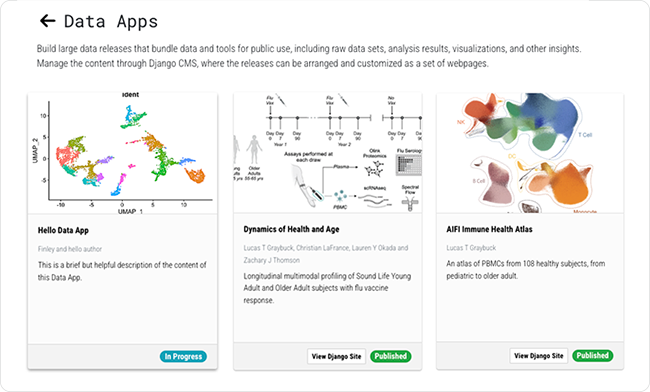Explore the Data Apps Platform
 | Abbreviations Key |
| AIFI | Allen Institute for Immunology |
| API | application programming interface |
| CertPro | Certificate of Reproducibility |
| CMS | content management system |
| HISE | Human Immune System Explorer |
| IDE | integrated development environment |
| LIMS | laboratory information management system |
| PHI | protected health information |
| SLIMS | simple laboratory information management system |
| UI | user interface |
At a Glance
Data Apps is a dynamic platform that showcases the data and computational resources in HISE, helps scientists apply AIFI research, awards certificates of reproducibility, and encourages exploration. Each Data Apps instance turns a static presentation of scientific research into a versatile asset package that can include multiple studies in a customizable UI. To set up a Data App, contact immunology-support@alleninstitute.org.
Description
You can present related reports, data files, notebooks, and visualizations together in a complete package known as a Data App. The Data App represents your work and helps other scientists review your experimental data and analyses in context, validated by Certificates of Reproducibility (CertPros).
Audience
The audience for Data Apps ranges from citizen scientists to those with advanced degrees and many years of experience:
- Citizen scientists and other curious members of the public can get a bird's-eye view of AIFI research
- College students and grad school students can learn from your work or tinker with it themselves
- Scientists at other institutions can use AIFI data or confirm our results
- Analysts can perform their own analyses using AIFI data
- AIFI scientists and other users already familiar with HISE components, such as publications and visualizations, can move seamlessly to the new Data Apps platform to present their research
Components
You might already have a publication in an AIFI-associated space. Publications aren't just text—they can also include visualizations, file sets, and notebooks. So what's the difference between a publication and a Data App? First, the Data Apps platform has a specially designed UI that makes your finished work look like a custom-designed website. Second, you can include multiple studies in a Data App, whereas publications are limited to a single study.
Content
A Data App is a complete work that explores a particular scientific question. A Data Apps release must include a hero image, a study, and identifying metadata, such as title and authors. To support your work, you can also attach additional assets, such as file sets, notebooks, visualizations, and certificates of reproducibility (CertPros).
Assets
An asset is a content component of a Data App, such as a study, visualization, file set, notebook, or CertPro.
Studies
The work that makes up the content of your Data App is prepared in a study space. A study holds everything in your Data App—all the assets discussed below, as well as any files you upload, such as images and PDFs. A study space is a workspace for collaboration within a HISE project, and the project is the organizing entity that enables cloud services (such as APIs, authentication, and billing) to run in your study space.
A study can be shared with anyone who has a Google account. The collaborator need not be a HISE user. Each study space has a hero (thumbnail) image in the top half of the tile and the title, author, description, and status (such as In Progress) in the bottom half of the tile.
File sets
File sets are selected file collections that users want to use again or share with others. For details, see Work with File Sets.
Notebooks
Jupyter notebook is an open-source web app that lets data analysts create and share documents and code. This notebook serves as an IDE. For details, see Use Jupyter Notebooks.
Visualizations
Any saved visualization in a study can be part of a Data App. For example, you could use a No-Code Visualization and Analysis (NOVA) visualization, a Dash App , or a visualization saved from an advanced search in HISE. For details, see Build and Save Visualizations or Use Built-In Visualization Tools. .
Certificates of Reproducibility
A CertPro is a detailed, step-by-step record of your scientific research (including your data, scientific algorithms, computational environment, tools stack, and findings) generated in real time to foster reliable reproducibility of study results. Certificates are awarded for file sets, visualizations, and notebooks. Reports and GitHub repositories are not eligible for certification. For details, see Understand Certificates of Reproducibility.
Data Apps UI
Customizable UI
The Data Apps platform offers a customizable UI for presentation of Data Apps assets. The UI is built on the open source Django platform. For help, see the Django documentation. To request access to the Django CMS, contact immunology-support@alleninstitute.org.
Templates
For a consistent look and feel, the Data Apps platform offers preconfigured UI templates. All you have to do is upload your content into the template.
Explore portal
The Explore Portal is an executable environment for presentation and storage of Data Apps. Data Apps are built in the HISE Collaboration Space and move to the Explore portal when published. This site lets you spotlight your work in an Allen Institute–affiliated space. Portal visitors can search available publications, review or execute certificates of reproducibility, browse visualizations, or access the data sets associated with each publication.

Data Apps Approval Process
Each Data App must be approved before it appears in the Explore portal. To request approval, you must have access to the studies in the Data App. The package is reviewed to ensure that the metadata, such as author and funding info, is complete, and that PHI is adequately masked in the CertPro. If revision is needed, the Data App is returned to the submitter for updates. If it's approved, a DOI is assigned, the submitter is notified by email, and the Data App moves from Preparation to Published status.

 Related Resources
Related Resources